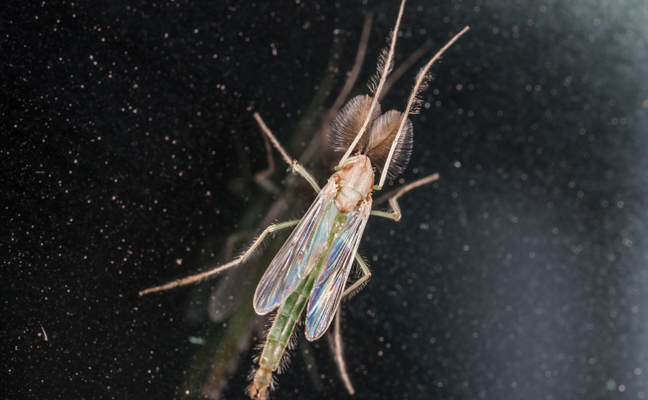
PHOTO: SIMAK/ISTOCK / GETTY IMAGES PLUS/GETTY IMAGES
QUESTION:
I get more complaints from my customers about gnats than I do mosquitoes. Don’t they breed in the same areas? What can I do about the thousands of them that coat the sides of lakeside houses?
—GNATS ALL, FOLKS
ANSWER:
You didn’t say they were biting, so I’m going to assume we’re talking about non-biting midges. In the situation you’re describing, I’m also going to assume they are in the family Chironomidae, which means they are aquatic midges. They have several common names that vary by region, including lake flies, bay flies, muckleheads, muffleheads, blind mosquitoes, chizzywinks and (erroneously) sand flies.
These guys are often mistaken for mosquitoes, and to the naked eye they do look somewhat similar. But as non-biters, chironomids have a different type of mouthparts than the mosquito. You won’t see a significant proboscis on the midge. Another quick way to tell the difference is that a midge, when at rest, holds its wings like a “V” on its back; a mosquito folds its wings on top of its abdomen. Also, the midges aren’t biting you — so that’s a pretty big clue.
Make sure you have the state license you need to perform work against chironomids, and that you use products labeled for them if they are your target pest and you are in a “label” state. If you are in a state that only requires the “site” to be on the label, then you have many more product options.
REDUCE ATTRACTION
Chironomids are night fliers. Any advice you can give your customers on reducing attractive lights on their houses, and creating decoy/attractive lighting away from their houses will help. Midges are weak fliers, so positive air pressure in the home can help keep them from bothering your customers inside their homes.
REDUCE BREEDING SITES
This is easier said than done. Ponds, lakes and stormwater runoff ponds are common sources of chironomids. A healthy pond is generally going to reduce midge breeding, but if the pond is not on your customer’s property, pond maintenance is not an option.
Insect growth regulators (IGRs) labeled for mosquito larvae can have an impact, and are likely your best bet treatment-wise. They enable you to affect the larvae population, so they do not become adults.
TARGET RESTING SITES
One approach that can give some temporary relief is to treat the resting areas around any lights that are on at night against the house. You’ll also affect the hundreds of spiders that will be drawn to this area because of the presence of midges — but while it can have some effect, this type of treatment will not permanently solve the problem.
I have never tried creating a “kill zone” at a residential property, but I have seen this method work many times in commercial situations. If decoy lighting is installed, you can provide a landing surface at the decoy and treat this decoy surface, creating a “kill zone.” Again, this won’t eliminate the issue, but may provide some relief.
Read more: Check out “Midge hatches are a sight to behold” for the author’s experience with a midge hatch event.
Email your questions about insect identification and pest management technologies to pmpeditor@northcoastmedia.net. Your questions most likely will be printed and answered in one of Pest Management Professional’s upcoming columns.
BLACK is a PMP Hall of Fame member (Class of 2019) and VP of quality assurance and technical service for Rollins Inc. She may be reached at jblack@rollins.com.
Leave A Comment